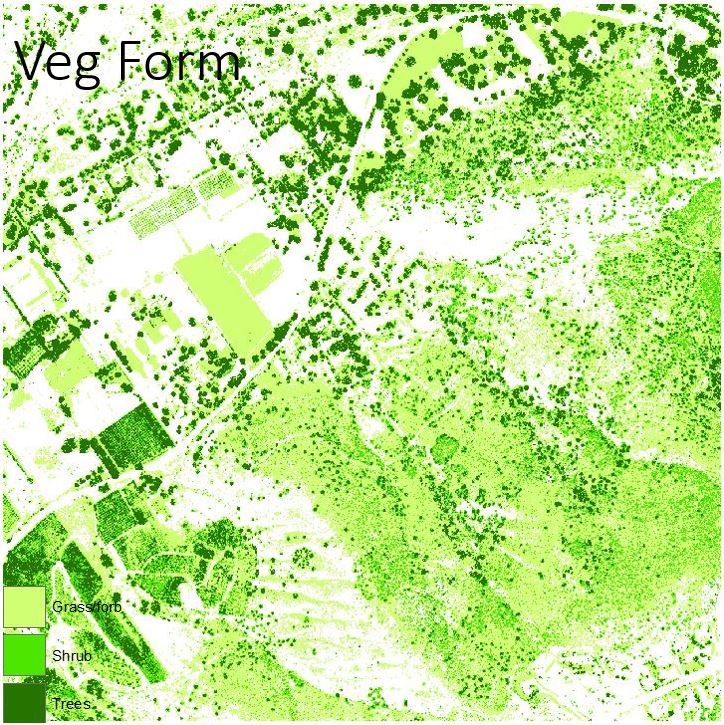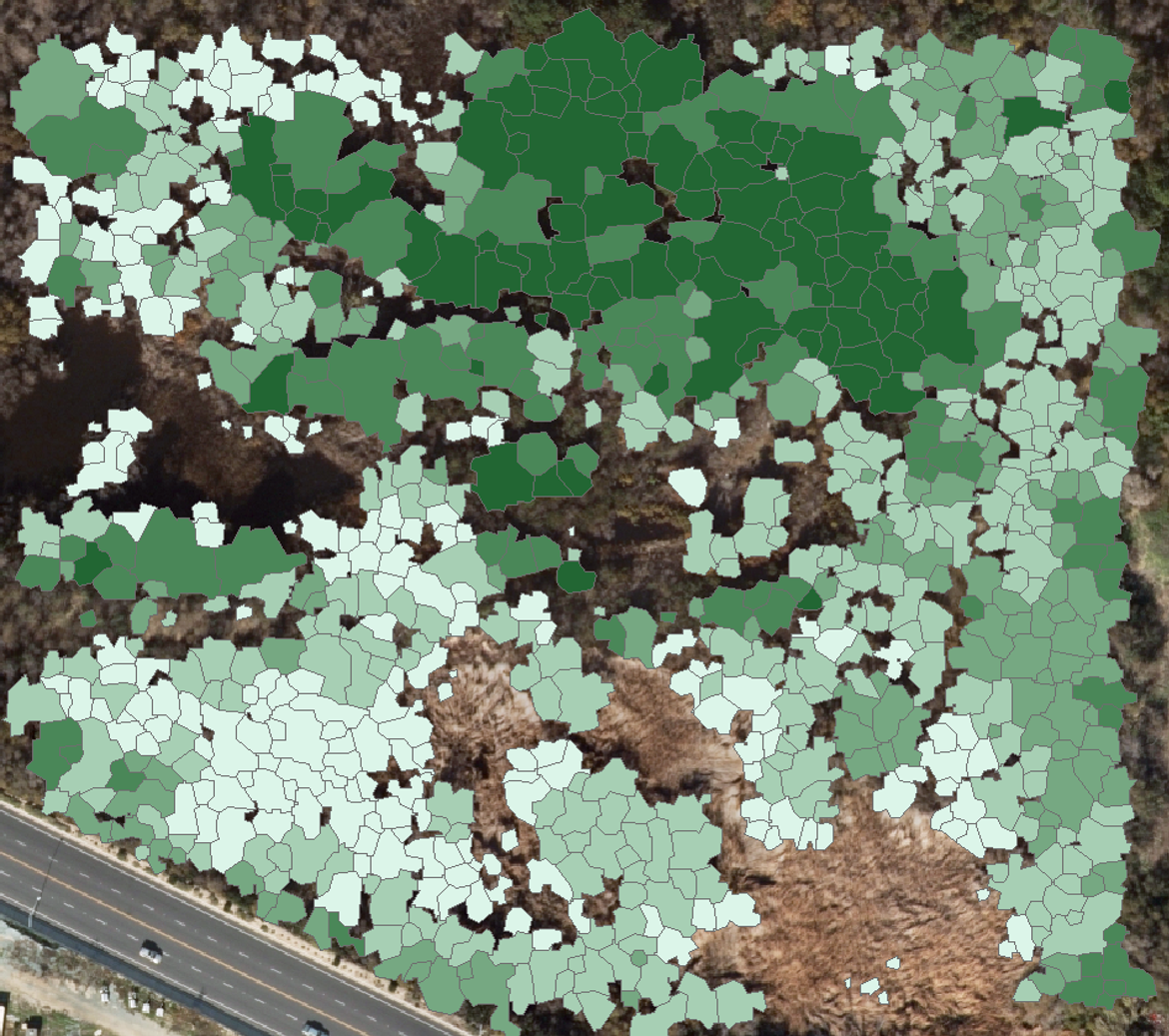2017-2019 Developing a Map of Ecological Integrity Using Remote Sensing
This project's objective is to create a map of ecological integrity using remotely sensed data. Data sources include high resolution lidar and high resolution 4-band imagery from multiple sources. Final products from this work will include: 1) an updated high resolution Digital Elevation Model, 2) an updated high resolution Digital Surface Model, 3) a raster image depicting vegetation height (using lidar), 4) a raster image depicting herbaceous, shrub, and tree cover, 5) a map layer of ecological integrity (at a 50m grid) for coastal sage scrub, chaparral, oak woodlands, and riparian woodlands. Ecological integrity is defined for each vegetation community independently, based on analysis of previous field work. This project will build off the information and products previously created.
Project Groups
-
SDMMP31 Vegetation Monitoring Methods
Project Focus
chaparral, coastal sage scrub, grassland, oak woodland, riparian forest & scrub
San Diego Management and Monitoring Program
Emily Perkins
Emily Perkins
Emily Perkins
Project Protocol
coastal sage scrub
Goal: Maintain, enhance and restore coastal sage scrub on Conserved Lands in the MSPA that supports or has the potential to support VF species (i.e., cliff spurge, Palmer's goldenbush, San Diego barrel cactus, snake cholla, Blaineville's horned lizard, California gnatcatcher, San Diego black-tailed jackrabbit) and to incidentally benefit a diverse array of other species (e.g., San Diego thornmint, Hermes copper, Quino checkerspot, coastal cactus wren) so that the vegetation community has high ecological integrity, and these species are resilient to environmental stochasticity, catastrophic disturbances and threats, such as very large wildfires, invasive plants and prolonged drought, and will be likely to persist over the long term (>100 years).
MON-DEV-MAP COSASC-2
Management units: 1, 2, 3, 4, 5, 6, 7, 8, 9, 10, 11
In 2017, develop a landscape-scale map classifying ecological integrity of shrublands across the MSPA based upon shrub cover and density and invasive nonnative annual grasses using remote imagery (e.g., satellite and high resolution aerial imagery, LIDAR) and vegetation data collected during 2015-2016 California gnatcatcher regional and postfire monitoring. Verify and revise the mapping as needed using field data collected in 2018-2020 as part of the Chaparral, Coastal Sage Scrub and Grassland Monitoring Program and from related VF species monitoring (e.g., California gnatcatcher regional and postfire monitoring). Revise the integrity classification map as needed to respond to changes in vegetation based upon wildfires, drought or other large-scale disturbances.
| Action | Statement | Action status | Projects |
|---|---|---|---|
| DEV-1 | Submit project metadata, datasets, analyses, and Ecological Integrity Classification Map to the MSP web portal | In progress | 2017-2019 Developing a Map of Ecological Integrity Using Remote Sensing, 2023-2024 Coastal sage scrub and chaparral community monitoring for western San Diego County |
| Criteria | Deadline year |
|---|---|
| Ecological Integrity Map created in 2017 and updated as needed 2018-2021 | 2021 |
| Threat Name | Threat Code |
|---|---|
| Altered fire regime | ALTFIR |
| Climate change | CLICHN |
| Invasive plants | INVPLA |
| Loss of ecological integrity | ECOINT |
chaparral
Goal: Maintain, enhance and restore chaparral on Conserved Lands in the MSPA that supports or has the potential to support VF species (i.e., Del Mar manzanita, felt-leaved monardella, Lakeside ceanothus, Nuttall's scrub oak, Otay manzanita, Rainbow manzanita, wart-stemmed ceanothus, California newt, Bell's sage sparrow) and to incidentally benefit a diverse array of other species (e.g., Encinitas baccharis, Jennifer's monardella, Orcutt's hazardia, mountain lion) so that the vegetation community has high ecological integrity, and these species are resilient to environmental stochasticity, catastrophic disturbances and threats, such as very large wildfires and prolonged droughts, and will be likely to persist over the long term (>100 years).
MON-DEV-MAP CHAPAR-2
Management units: 1, 2, 3, 4, 5, 6, 7, 8, 9, 10, 11
In 2017, develop a landscape-scale map classifying ecological integrity of shrublands across the MSPA based upon shrub cover and density and invasive nonnative annual grasses using remote imagery (e.g., satellite and high resolution aerial imagery, LIDAR) and vegetation data collected during 2015-2016 California gnatcatcher regional and postfire monitoring. Verify and revise the mapping as needed using field data collected in 2018-2020 as part of the Chaparral, Coastal Sage Scrub and Grassland Vegetation Monitoring Program and from related VF species monitoring (e.g., California gnatcatcher regional and postfire monitoring). Revise the integrity classification map as needed to respond to changes in vegetation based upon wildfires, drought or other large-scale disturbances.
| Action | Statement | Action status | Projects |
|---|---|---|---|
| DEV-1 | Submit project metadata, datasets, analyses, and Ecological Integrity Classification Map to the MSP web portal | In progress | 2017-2019 Developing a Map of Ecological Integrity Using Remote Sensing, 2023-2024 Coastal sage scrub and chaparral community monitoring for western San Diego County |
| Criteria | Deadline year |
|---|---|
| Ecological Integrity Map created in 2017 and updated as needed 2018-2021 | 2021 |
| Threat Name | Threat Code |
|---|---|
| Altered fire regime | ALTFIR |
| Climate change | CLICHN |
| Invasive plants | INVPLA |
| Loss of ecological integrity | ECOINT |
oak woodland
Goal: Maintain, enhance and restore oak woodlands on Conserved Lands in the MSPA that support or have the potential to support VF species (i.e., Engelmann Oak, California newt) and coast live oak woodlands that incidentally benefit a diverse array of other MSP species (e.g., Harbison's dun skipper, California newt, pallid bat, mountain lion) so that the vegetation communities have high ecological integrity, and these species are resilient to invasive pests and disease pathogens, environmental stochasticity, threats and catastrophic disturbances, such as very large wildfires and intense and prolonged drought, and will be likely to persist over the long term (>100 years).
MON-DEV-MAP OAKWOO-1
Management units: 2, 3, 4, 5, 6, 8, 9, 10, 11
Starting in 2017, map tree mortality in oak woodlands across the MSPA using high resolution aerial imagery, LIDAR and other remote sensing data and incorporate existing datasets, where available, to determine the current status of oak woodlands in the MSPA that are affected by drought, wildfire and invasive pests and fungal pathogens.
| Action | Statement | Action status | Projects |
|---|---|---|---|
| DEV-1 | Submit project metadata, datasets, analyses, and Oak Woodland Tree Mortality Map to the MSP web portal | In progress | 2017-2019 Developing a Map of Ecological Integrity Using Remote Sensing |
| Criteria | Deadline year |
|---|---|
| Oak Woodland Tree Mortality Map completed by 2018 | 2021 |
| Threat Name | Threat Code |
|---|---|
| Altered fire regime | ALTFIR |
| Altered hydrology | ALTHYD |
| Climate change | CLICHN |
| Herbivory/predation | |
| Invasive animals | INVANI |
| Invasive plants | INVPLA |
| Loss of ecological integrity | ECOINT |
| Parasitism/disease | |
| Urban development | URBDEV |
grassland
Goal: Enhance and restore native grasslands and forblands and manage nonnative grasslands on Conserved Lands in the MSPA that support or have the potential to support VF species (i.e., grasshopper sparrow and San Diego black-tailed jackrabbit) and to incidentally benefit a diverse array of other species (e.g., Quino checkerspot, burrowing owl, golden eagle, Stephen's kangaroo rat) so that the vegetation communities have high ecological integrity, and these species are resilient to environmental stochasticity and will be likely to persist over the long term (>100 years).
MON-DEV-MAP GRASSL-2
Management units: 1, 2, 3, 4, 5, 6, 7, 8, 9, 10, 11
In 2017, develop a landscape-scale map classifying ecological integrity of shrublands across the MSPA based upon shrub cover and density and invasive nonnative annual grasses using remote imagery (e.g., satellite and high resolution aerial imagery, LIDAR) and vegetation data collected during 2015-2016 California gnatcatcher regional and postfire monitoring. Verify and revise the mapping as needed using field data collected in 2018-2020 as part of the Chaparral, Coastal Sage Scrub and Grassland Monitoring Program and from related VF species monitoring (e.g., California gnatcatcher regional and postfire monitoring). Revise the integrity classification map as needed to respond to changes in vegetation based upon wildfires, drought or other large-scale disturbances.
| Action | Statement | Action status | Projects |
|---|---|---|---|
| DEV-1 | Submit project metadata, datasets, analyses, and Ecological Integrity Classification Map to the MSP web portal | In progress | 2017-2019 Developing a Map of Ecological Integrity Using Remote Sensing |
| Criteria | Deadline year |
|---|---|
| Ecological Integrity Map created in 2017 and updated as needed 2018-2021 | 2021 |
| Threat Name | Threat Code |
|---|---|
| Altered fire regime | ALTFIR |
| Climate change | CLICHN |
| Invasive plants | INVPLA |
| Loss of ecological integrity | ECOINT |
riparian forest & scrub
Goal: Maintain, enhance and restore riparian forest and scrub on Conserved Lands in the MSPA that supports or has the potential to support VF species (i.e., California newt, yellow-breasted chat) and to incidentally benefit a diverse array of other species (e.g., arroyo toad, southwestern pond turtle, least Bell's vireo, southwestern willow flycatcher, Townsend's big-eared bat) so that the vegetation community has high ecological integrity, and these species are resilient to invasive pests and disease pathogens, environmental stochasticity, threats and catastrophic disturbances, such as very large wildfires and intense and prolonged drought, and will be likely to persist over the long term (>100 years).
MON-DEV-MAP RIPFOR-1
Management units: 1, 2, 3, 4, 5, 6, 7, 8, 9, 10, 11
In 2017-2018, map tree mortality in riparian forests across the MSPA using high resolution aerial imagery, LIDAR and other remote sensing data and incorporate existing datasets, where available, to determine the current status of riparian forest and scrub in the MSPA that are affected by drought, wildfire and invasive pests and fungal pathogens.
| Action | Statement | Action status | Projects |
|---|---|---|---|
| DEV-1 | Submit project metadata, datasets, analyses, and Riparian Forest Tree Mortality Map to the MSP web portal | In progress | 2017-2019 Developing a Map of Ecological Integrity Using Remote Sensing |
| Criteria | Deadline year |
|---|---|
| Riparian Forest and Scrub Mortality Map completed by 2018 | 2021 |
| Threat Name | Threat Code |
|---|---|
| Altered fire regime | ALTFIR |
| Altered hydrology | ALTHYD |
| Climate change | CLICHN |
| Herbivory/predation | |
| Invasive animals | INVANI |
| Invasive plants | INVPLA |
| Loss of ecological integrity | ECOINT |
| Parasitism/disease | |
| Urban development | URBDEV |
| File name | Lead Author | Year | Type |
|---|---|---|---|
| Modeling Ecological Integrity Using High-Resolution Imagery and Lidar | Perkins, Emily | 2020 | powerpoint presentation |
| Vegetation Height in Open Space in San Diego County, Derived from 2014 NAIP Imagery and 2014/2015 Lidar | Perkins, Emily | GIS data |

